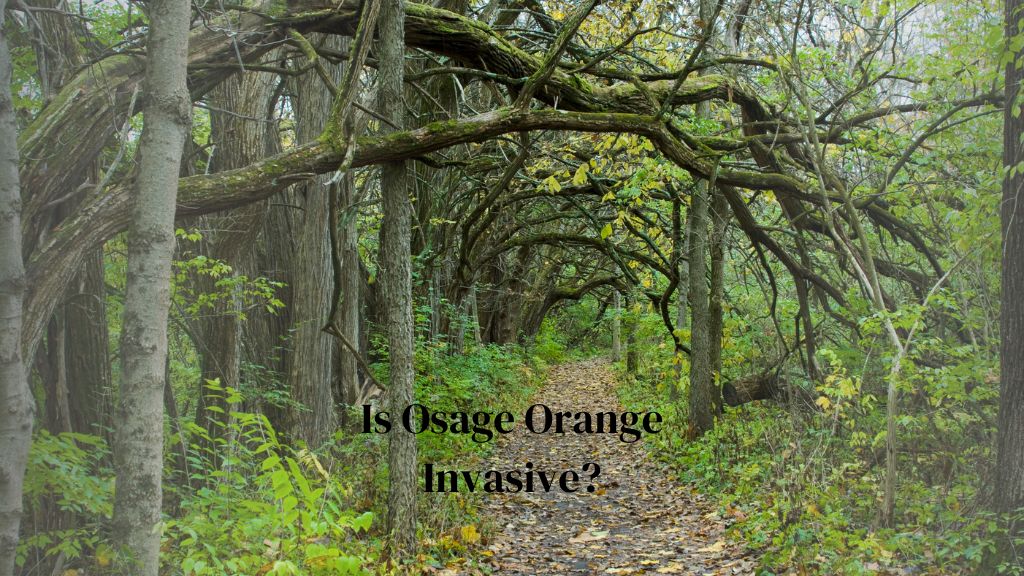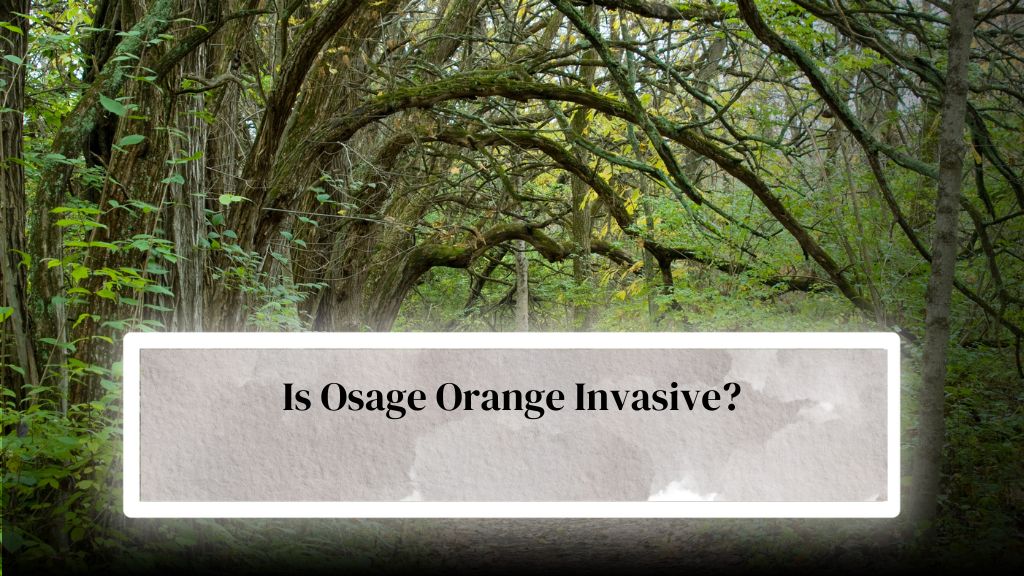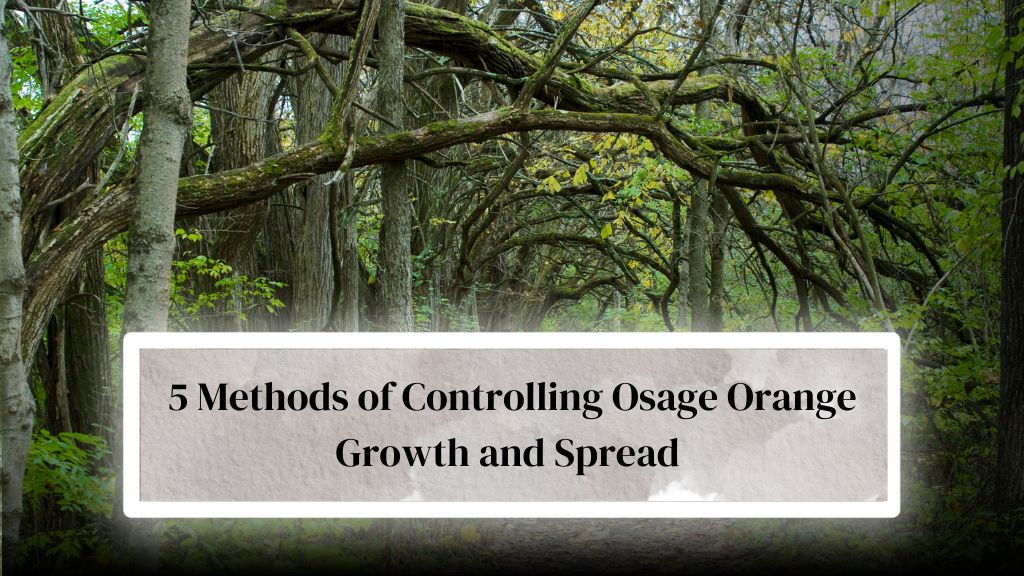
Since Osage Orange trees are very common in the United States, you might wonder, ‘Is Osage Orange Invasive?’. In this article, we will explore both sides of the argument and examine the factors that affect the tree’s invasiveness.
You should know that this specimen is particularly considered a non-concerning species, even though they are invasive. These trees are widely used as a hedge or fences, and you can also use their fruit to repel insects. However, let’s first understand: is Osage Orange Invasive?
Is Osage Orange Invasive?

Yes, Osage orange is invasive. A study by the United States Department of Agriculture found that Osage Orange is invasive, invaded areas outside its natural range, including forests, fields, and roadsides, and was growing in dense stands. The study also noted that Osage Orange produced seeds dispersed by birds and other wildlife, further increasing its spread.
Many experts argue that Osage Orange is invasive because it has been introduced to areas outside its natural range. Plus, this specimen can also reproduce & spread rapidly. You should note that invasive species are “non-native organisms that cause harm to the economy, environment, or human health.”
In some areas & parts of the eastern United States, Osage Orange meets the invasiveness criteria. However, many people also argue that Osage Orange is not invasive because it possesses the same degree of negative impacts commonly associated with invasive species.
You don’t need to worry about osage orange outcompeting your native vegetation or disrupting ecosystems to the same extent as other invasive species like kudzu or Japanese knotweed.
Many studies prove Osage Orange also has many positive ecological impacts. In grasslands, Osage Orange helps to increase plant diversity by providing a habitat for small mammals that disperse plant seeds.
You should also know that we have cultivated Osage Orange for centuries, and this specimen has played many important roles in our history. If you check our history, you’ll know that Native Americans used osage orange wood to make bows, while early settlers used it to build fences & shelters.
Apart from this, the osage orange tree also has cultural significance, like this specimen is the state tree of Texas. Since there’s a huge debate on Osage Orange’s invasiveness nature, let’s take a quick look at the factors that affect it.
3 Factors That Affect Invasiveness
You should know that Osage orange is only Invasive when you expose them to poorly managed range & pasture land. However, their invasive nature is influenced by various factors, including climate, geography, soil, nutrient availability, & and human intervention. So, let’s take a quick look at it.
Climate & Geography
You should know that Osage Orange is adapted to the hot, humid climate of the central and southern United States. Therefore, this specimen can tolerate a wide range of temperatures & soil conditions.
However, Osage orange is best grown in well-drained soils and areas with high humidity. If you’re thinking of planting an Osage Orange tree In areas outside its natural range, it may struggle to survive in harsh climates.
Soil & Nutrient Availability
Interestingly, Osage Orange is a hardy tree that can also grow in poor soils and tolerate drought. However, it thrives in nutrient-rich soils. Thus, I’ll always advise you to provide them nitrogen-rich fertilizer in springtime. But, you should note that Osage oranges may grow more vigorously in areas where nutrients are readily available.
Human Intervention & Disturbance
Many types of human activities like land use change & disturbance Often increase the likelihood of a species becoming invasive. If your Osage Orange has been planted as a hedgerow or fence, it may spread into nearby areas through human activity.
Spread of Osage Orange
Natural Spread of Osage Orange
Primarily, Osage orange trees are often dispersed by animals that eat their fruit, including squirrels, deer, & cattle. The seeds are then spread through their feces, allowing the tree to establish in new areas. In addition, the osage orange trees can also spread through root suckering, where new trees sprout from the roots of mature trees.
Also Read: Are Osage Oranges Edible?
Human-mediated Spread of Osage Orange
As I told you earlier, Human activities like planting and landscaping have also contributed to the spread of Osage orange. People planted this specimen in the Great Plains during the 19th century as a windbreak. Moreover, its fruits were used as a natural insect repellent.
Today, the tree is still commonly used as a fence row tree, and its wood is highly valued for its strength & durability. We often use osage orange wood in art & craft and woodworking. If you also want to use this wood for your woodworking projects, consider reading: Where To Buy Osage Orange Wood.
Related: How To Eat An Osage Orange?
5 Methods of Controlling Osage Orange Growth and Spread

Mechanical control
The mechanical control method is said to be very difficult for beginners to try out. Plus, it can also be very time-consuming for large trees or tough wood. Since Orange Woods tends to be highly durable & strong, it’s better if you get a professional involved in this. This method usually involves physically removing a large tree or simply cutting it down.
Chemical control
This is not the method I recommend because it may also damage the surrounding environment & plants. However, you can use herbicide to kill your tree or prevent it from sprouting. You should note that chemical control methods can potentially harm other plants in your areas, so be careful with their application and wear gloves.
Biological control
Another method to control the growth of an osage orange tree or any other trees you don’t want is a biological method. You can consider introducing natural enemies where osage trees are grown in your landscape.
Many types of diseases and insects can help you control the growth of an Osage orange tree, but consider this method carefully to prevent unintended consequences.
Cultural control
You can also consider altering soil conditions, making it less suitable for tree growth. Well, this method involves changing land management practices, like reducing grazing pressure or altering soil conditions, to make the area less suitable for the Osage orange to thrive and grow more.
Integrated pest management
Lastly, consider combining multiple control methods to achieve the most effective & sustainable control of Osage orange. If the tree is large, getting an arborist involved is best. They might consider professional pruning of the tree roots & shrubs.
Related: How to Grow Osage Orange Trees: A Comprehensive Guide
Ecological Impacts of Osage Orange
Positive Ecological Impacts of Osage Orange
You should know that Osage oranges provide important ecological benefits. In their natural habitat, this species serves as a habitat for wildlife. In some areas, they also help reduce soil erosion and act as a windbreak.
Osage orange tree’s wood is also highly valued for its strength & durability, making it an important resource for us. If you have these trees on your landscape, consider determining whether it’s harming the surrounding environment & ecology.
Negative Ecological Impacts of Osage Orange
As I told you, people often debate Osage orange invasiveness because it also has negative ecological impacts. This tree has also been noticed displacing native plant species, altering nutrient cycling, & negatively impacting wildlife populations in a few cases.
In addition, the tree is large and has a dense canopy, which can easily shade out other plant species & reduce plant diversity. According to a study by USDA, Osage orange has invaded and colonized riparian habitats in the southern Great Plains, causing negative ecological impacts on plant communities and reducing biodiversity.
Related article: What Are Osage Oranges Good For?
Conclusion
Even though Osage orange has the potential to be invasive & cause negative impacts on native plant communities, It also has many important ecological benefits.
Therefore, you must take proper precautions to manage the spread of the tree by effective control measures & sustainable land management practices. I’ve given my best to give you useful information on osage orange tree invasive nature.
If you find this article helpful, then consider sharing it. Your share will help many people learn about the invasive nature of this tree and how they can control these species’ spread.
Check our other helpful guide on osage orange tree care & management on this website. See you in the next post; till then, take care and goodbye.
